2018年高考英语浙江卷(附答案)
- 格式:docx
- 大小:35.42 KB
- 文档页数:11
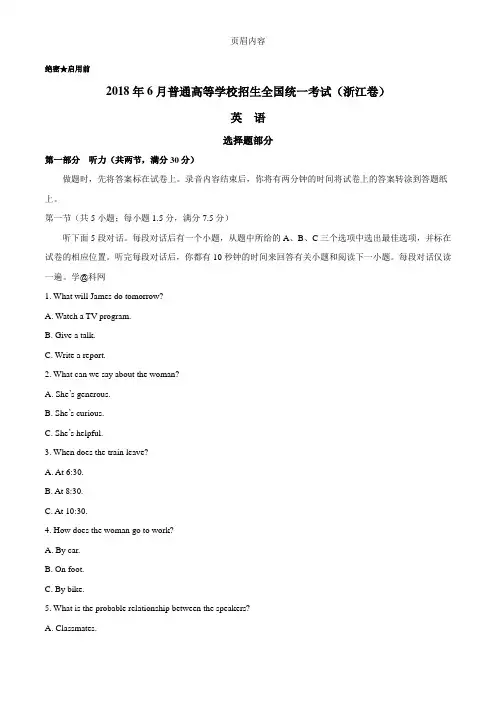
绝密★启用前2018年6月普通高等学校招生全国统一考试(浙江卷)英语选择题部分第一部分听力(共两节,满分30分)做题时,先将答案标在试卷上。
录音内容结束后,你将有两分钟的时间将试卷上的答案转涂到答题纸上。
第一节(共5小题;每小题1.5分,满分7.5分)听下面5段对话。
每段对话后有一个小题,从题中所给的A、B、C三个选项中选出最佳选项,并标在试卷的相应位置。
听完每段对话后,你都有10秒钟的时间来回答有关小题和阅读下一小题。
每段对话仅读一遍。
学@科网1. What will James do tomorrow?A. Watch a TV program.B. Give a talk.C. Write a report.2. What can we say about the woman?A. She’s generous.B. She’s curious.C. She’s helpful.3. When does the train leave?A. At 6:30.B. At 8:30.C. At 10:30.4. How does the woman go to work?A. By car.B. On foot.C. By bike.5. What is the probable relationship between the speakers?A. Classmates.B. Teacher and student.C. Doctor and patient.第二节(共15小题;每小题1.5分,满分22.5分)听下面5段对话或独白。
每段对话或独白后有几个小题,从题中所给的A、B、C三个选项中选出最佳选项,并标在试卷的相应位置。
听每段对话或独白前,你将有时间阅读各个小题,每小题5秒钟;听完后,各小题将给出5秒钟的作答时间。
每段对话或独白读两遍。
听第6段材料,回答第6、7题。
6. What does the woman regret?A. Giving up her research.B. Dropping out of college.C. Changing her major.7. What is the woman interested in studying now?A. Ecology.B. Education.C. Chemistry.听第7段材料,回答第8、9题。
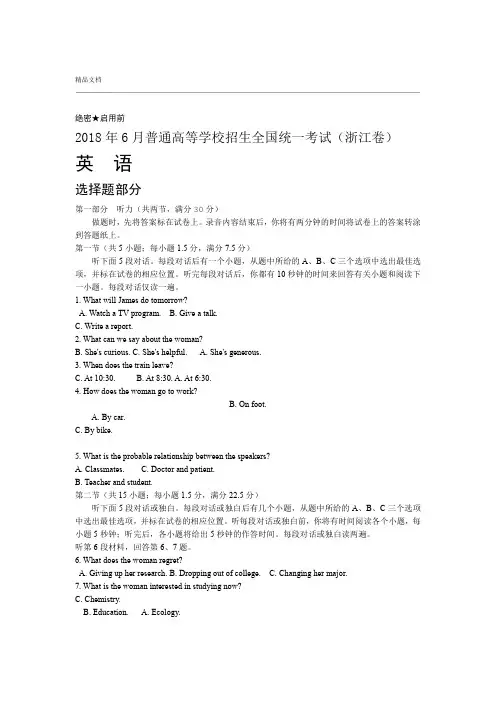
精品文档绝密★启用前2018年6月普通高等学校招生全国统一考试(浙江卷)英语选择题部分第一部分听力(共两节,满分30分)做题时,先将答案标在试卷上。
录音内容结束后,你将有两分钟的时间将试卷上的答案转涂到答题纸上。
第一节(共5小题;每小题1.5分,满分7.5分)听下面5段对话。
每段对话后有一个小题,从题中所给的A、B、C三个选项中选出最佳选项,并标在试卷的相应位置。
听完每段对话后,你都有10秒钟的时间来回答有关小题和阅读下一小题。
每段对话仅读一遍。
1. What will James do tomorrow?A. Watch a TV program.B. Give a talk.C. Write a report.2. What can we say about the woman?B. She's curious.C. She's helpful. A. She's generous.3. When does the train leave?C. At 10:30. B. At 8:30. A. At 6:30.4. How does the woman go to work?B. On foot.A. By car.C. By bike.5. What is the probable relationship between the speakers?A. Classmates. C. Doctor and patient.B. Teacher and student.第二节(共15小题;每小题1.5分,满分22.5分)听下面5段对话或独白。
每段对话或独白后有几个小题,从题中所给的A、B、C三个选项中选出最佳选项,并标在试卷的相应位置。
听每段对话或独白前,你将有时间阅读各个小题,每小题5秒钟;听完后,各小题将给出5秒钟的作答时间。
每段对话或独白读两遍。
听第6段材料,回答第6、7题。
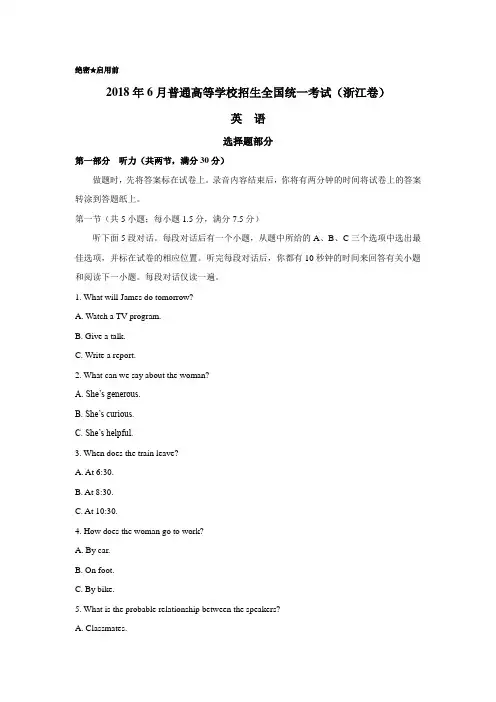
绝密★启用前2018年6月普通高等学校招生全国统一考试(浙江卷)英语选择题部分第一部分听力(共两节,满分30分)做题时,先将答案标在试卷上。
录音内容结束后,你将有两分钟的时间将试卷上的答案转涂到答题纸上。
第一节(共5小题;每小题1.5分,满分7.5分)听下面5段对话。
每段对话后有一个小题,从题中所给的A、B、C三个选项中选出最佳选项,并标在试卷的相应位置。
听完每段对话后,你都有10秒钟的时间来回答有关小题和阅读下一小题。
每段对话仅读一遍。
1. What will James do tomorrow?A. Watch a TV program.B. Give a talk.C. Write a report.2. What can we say about the woman?A. She’s generous.B. She’s curious.C. She’s helpful.3. When does the train leave?A. At 6:30.B. At 8:30.C. At 10:30.4. How does the woman go to work?A. By car.B. On foot.C. By bike.5. What is the probable relationship between the speakers?A. Classmates.B. Teacher and student.C. Doctor and patient.第二节(共15小题;每小题1.5分,满分22.5分)听下面5段对话或独白。
每段对话或独白后有几个小题,从题中所给的A、B、C三个选项中选出最佳选项,并标在试卷的相应位置。
听每段对话或独白前,你将有时间阅读各个小题,每小题5秒钟;听完后,各小题将给出5秒钟的作答时间。
每段对话或独白读两遍。
听第6段材料,回答第6、7题。
6. What does the woman regret?A. Giving up her research.B. Dropping out of college.C. Changing her major.7. What is the woman interested in studying now?A. Ecology.B. Education.C. Chemistry.听第7段材料,回答第8、9题。
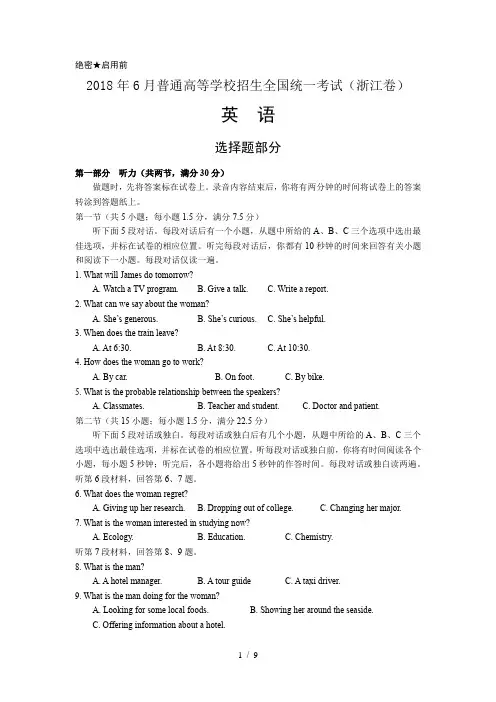
绝密★启用前2018年6月普通高等学校招生全国统一考试(浙江卷)英语选择题部分第一部分听力(共两节,满分30分)做题时,先将答案标在试卷上。
录音内容结束后,你将有两分钟的时间将试卷上的答案转涂到答题纸上。
第一节(共5小题;每小题1.5分,满分7.5分)听下面5段对话。
每段对话后有一个小题,从题中所给的A、B、C三个选项中选出最佳选项,并标在试卷的相应位置。
听完每段对话后,你都有10秒钟的时间来回答有关小题和阅读下一小题。
每段对话仅读一遍。
1. What will James do tomorrow?A. Watch a TV program.B. Give a talk.C. Write a report.2. What can we say about the woman?A. She’s generous.B. She’s curious.C. She’s helpful.3. When does the train leave?A. At 6:30.B. At 8:30.C. At 10:30.4. How does the woman go to work?A. By car.B. On foot.C. By bike.5. What is the probable relationship between the speakers?A. Classmates.B. Teacher and student.C. Doctor and patient.第二节(共15小题;每小题1.5分,满分22.5分)听下面5段对话或独白。
每段对话或独白后有几个小题,从题中所给的A、B、C三个选项中选出最佳选项,并标在试卷的相应位置。
听每段对话或独白前,你将有时间阅读各个小题,每小题5秒钟;听完后,各小题将给出5秒钟的作答时间。
每段对话或独白读两遍。
听第6段材料,回答第6、7题。
6. What does the woman regret?A. Giving up her research.B. Dropping out of college.C. Changing her major.7. What is the woman interested in studying now?A. Ecology.B. Education.C. Chemistry.听第7段材料,回答第8、9题。
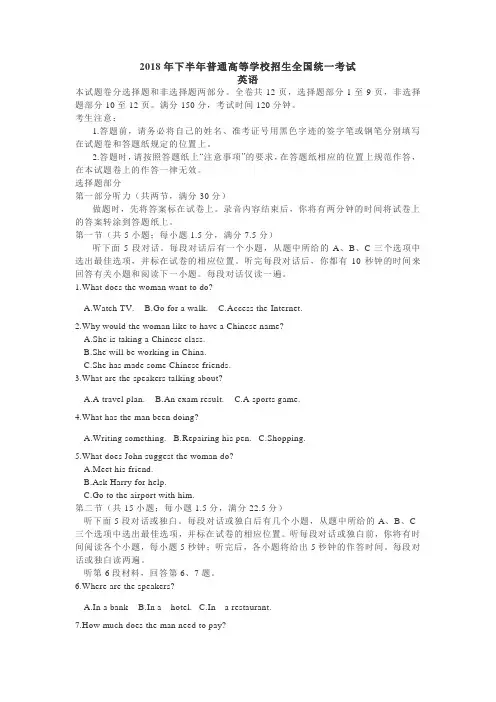
2018年下半年普通高等学校招生全国统一考试英语本试题卷分选择题和非选择题两部分。
全卷共12页,选择题部分1至9页,非选择题部分10至12页。
满分150分,考试时间120分钟。
考生注意:1.答题前,请务必将自己的姓名、准考证号用黑色字迹的签字笔或钢笔分别填写在试题卷和答题纸规定的位置上。
2.答题时,请按照答题纸上“注意事项”的要求,在答题纸相应的位置上规范作答,在本试题卷上的作答一律无效。
选择题部分第一部分听力(共两节,满分30分)做题时,先将答案标在试卷上。
录音内容结束后,你将有两分钟的时间将试卷上的答案转涂到答题纸上。
第一节(共5小题;每小题1.5分,满分7.5分)听下面5段对话。
每段对话后有一个小题,从题中所给的A、B、C三个选项中选出最佳选项,并标在试卷的相应位置。
听完每段对话后,你都有10秒钟的时间来回答有关小题和阅读下一小题。
每段对话仅读一遍。
1.What does the woman want to do?A.Watch TV.B.Go for a walk.C.Access the Internet.2.Why would the woman like to have a Chinese name?A.She is taking a Chinese class.B.She will be working in China.C.She has made some Chinese friends.3.What are the speakers talking about?A.A travel plan.B.An exam result.C.A sports game.4.What has the man been doing?A.Writing something.B.Repairing his pen.C.Shopping.5.What does John suggest the woman do?A.Meet his friend.B.Ask Harry for help.C.Go to the airport with him.第二节(共15小题;每小题1.5分,满分22.5分)听下面5段对话或独白。
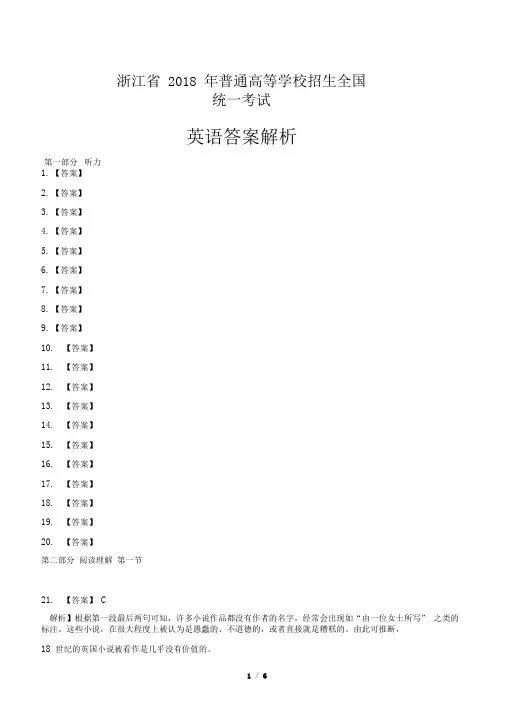
浙江省2018 年普通高等学校招生全国统一考试英语答案解析第一部分听力1.【答案】2.【答案】3.【答案】4.【答案】5.【答案】6.【答案】7.【答案】8.【答案】9.【答案】10.【答案】11.【答案】12.【答案】13.【答案】14.【答案】15.【答案】16.【答案】17.【答案】18.【答案】19.【答案】20.【答案】第二部分阅读理解第一节21.【答案】C解析】根据第一段最后两句可知,许多小说作品都没有作者的名字,经常会出现如“由一位女士所写” 之类的标注。
这些小说,在很大程度上被认为是愚蠢的、不道德的,或者直接就是糟糕的。
由此可推断,18 世纪的英国小说被看作是几乎没有价值的。
考点】推理判断。
22.【答案】D【解析】根据第二段最后一句“ Removing him from the pantheon of English literature would make about as much sense, as the Louvre selling off the Mona Lisa. ”可知,将他从英国文学的名人堂中移除,与卢浮宫廉价出售《蒙娜丽莎》的意义一样。
再根据第三段的内容可推断,把狄更斯与《蒙娜丽莎》相比旨在强调他在文学史上的重要性。
【考点】推理判断。
23.【答案】A 【解析】纵观全文,文章主要介绍了查尔斯·狄更斯在英国文学史上的地位。
由此可推断,作者写这篇文章是为了纪念一位伟大的作家。
【考点】目的意图。
B24.【答案】D 【解析】根据第一段最后一句及第二段最后一句可知,塑料袋制造商雇用了斯坦这样的科学家来倡导大家使用塑料袋。
【考点】细节理解。
25.【答案】A【解析】根据第二段第三句“ The bags are prohibited in some, 90 cities in California, including Los Angeles. ”可知,在加州包括洛杉矶在内的大约90个城市,塑料袋是被禁止使用的。
绝密★启用前2018年普通高等学校招生全国统一考试(浙江卷)英语选择题部分第一部分听力(共两节,满分30分)做题时,先将答案标在试卷上。
录音内容结束后,你将有两分钟的时间将试卷上的答案转涂到答题纸上。
第一节(共5小题;每小题1.5分,满分7.5分)听下面5段对话。
每段对话后有一个小题,从题中所给的A、B、C三个选项中选出最佳选项,并标在试卷的相应位置。
听完每段对话后,你都有10秒钟的时间来回答有关小题和阅读下一小题。
每段对话仅读一遍。
例:How much is the shirt?A. £19.15.B. £9.18.C. £9.15.答案是C。
1. What will James do tomorrow?A. Watch a TV program.B. Give a talk.C. Write a report.2. What can we say about the woman?A. She’s generous.B. She’s curious.C. She’s helpful.3. When does the train leave?A. At 6: 30.B. At 8: 30.C. At 10: 30.4. How does the woman go to work?A. By car.B. On foot.C. By bike.5. What is the probable relationship between the speakers?A. Classmates.B. Teacher and student.C. Doctor and patient.第二节(共15小题;每小题1.5分,满分22.5分)听下面5段对话或独白。
每段对话或独白后有几个小题,从题中所给的A、B、C三个选项中选出最佳选项,并标在试卷的相应位置。
听每段对话或独白前,你将有时间阅读各个小题,每小题5秒钟;听完后,各小题给出5秒钟的作答时间。
2018 年 11 月浙江省高考英语真题第一部分听力(共两节,满分 30 分)做题时,先将答案标在试卷上。
录音内容结束后,你将有两分钟的时间将试卷上的答案转涂到答题纸上。
第一节(共 5 小题;每题分,满分分)听下边 5 段对话。
每段对话后有一个小题,从题中所给的 A、B、C三个选项中选出最正确选项,并标在试卷的相应地点。
听完每段对话后,你都有10 秒钟的时间往返答相关小题和阅读下一小题。
每段对话仅读一遍。
例 :How much is the shirtA. £.B. £.C. £.答案是C。
1.What does the woman want to doA.Watch TV.B.Go for a walk.C.Access the Internet.2.Why would the woman like to have a Chinese nameA.She is taking a Chinese class.B.She will be working in China.C.She has made some Chinese friends.3.What are the speakers talking aboutA.A travel plan.B.An exam result.C.A sports game.4.What has the man been doingA.Writing something.B.Repairing his pen.C.Shopping.5.What does John suggest the woman doA.Meet his friend.B.Ask Harry for help.C.Go to the airport with him.第二节(共 15 小题;每题分,满分分)听下边 5 段对话或独白。
每段对话或独白后有几个小题,从题中所给的 A、B、C 三个选项中选出最正确选项,并标在试卷的相应地点。
绝密★启用前2018年6月普通高等学校招生全国统一考试(浙江卷)英语选择题部分第一部分听力(共两节,满分30分)做题时,先将答案标在试卷上。
录音内容结束后,你将有两分钟的时间将试卷上的答案转涂到答题纸上。
第一节(共5小题;每小题 1.5分,满分7.5分)听下面5段对话。
每段对话后有一个小题,从题中所给的A、B、C三个选项中选出最佳选项,并标在试卷的相应位置。
听完每段对话后,你都有10秒钟的时间来回答有关小题和阅读下一小题。
每段对话仅读一遍。
1. What will James do tomorrow?A. Watch a TV program.B. Give a talk.C. Write a report.2. What can we say about the woman?A. She’s generous.B. She’s curious.C. She’s helpful.3. When does the train leave?A. At 6:30.B. At 8:30.C. At 10:30.4. How does the woman go to work?A. By car.B. On foot.C. By bike.5. What is the probable relationship between the speakers?A. Classmates.B. Teacher and student.C. Doctor and patient.第二节(共15小题;每小题 1.5分,满分22.5分)听下面5段对话或独白。
每段对话或独白后有几个小题,从题中所给的A、B、C三个选项中选出最佳选项,并标在试卷的相应位置。
听每段对话或独白前,你将有时间阅读各个小题,每小题5秒钟;听完后,各小题将给出5秒钟的作答时间。
每段对话或独白读两遍。
听第6段材料,回答第6、7题。
6. What does the woman regret?A. Giving up her research.B. Dropping out of college.C. Changing her major.7. What is the woman interested in studying now?A. Ecology.B. Education.C. Chemistry.听第7段材料,回答第8、9题。
绝密★启用前2018年6月普通高等学校招生全国统一考试(浙江卷)英语选择题部分第一部分听力(共两节,满分30分)做题时,先将答案标在试卷上。
录音内容结束后,你将有两分钟的时间将试卷上的答案转涂到答题纸上。
第一节(共5小题;每小题1.5分,满分7.5分)听下面5段对话。
每段对话后有一个小题,从题中所给的A、B、C三个选项中选出最佳选项,并标在试卷的相应位置。
听完每段对话后,你都有10秒钟的时间来回答有关小题和阅读下一小题。
每段对话仅读一遍。
1. What will James do tomorrow?A. Watch a TV program.B. Give a talk.C. Write a report.2. What can we say about the woman?A. She’s generous.B. She’s curious.C. She’s helpful.3. When does the train leave?A. At 6:30.B. At 8:30.C. At 10:30.4. How does the woman go to work?A. By car.B. On foot.C. By bike.5. What is the probable relationship between the speakers?A. Classmates.B. Teacher and student.C. Doctor and patient.第二节(共15小题;每小题1.5分,满分22.5分)听下面5段对话或独白。
每段对话或独白后有几个小题,从题中所给的A、B、C三个选项中选出最佳选项,并标在试卷的相应位置。
听每段对话或独白前,你将有时间阅读各个小题,每小题5秒钟;听完后,各小题将给出5秒钟的作答时间。
每段对话或独白读两遍。
听第6段材料,回答第6、7题。
6. What does the woman regret?A. Giving up her research.B. Dropping out of college.C. Changing her major.7. What is the woman interested in studying now?A. Ecology.B. Education.C. Chemistry.听第7段材料,回答第8、9题。
英语第二部分阅读理解(共两节,满分35分)第一节(共10小题;每小题2.5分,满分25分)阅读下列短文,从每题所给的 A B、C和D四个选项中,选出最佳选项,并在答题纸上将该项涂黑。
AIn 1812, the year Charles Dicke ns was born, there were 66 no vels publishedin Brita in. People had bee n writi ng no vels for a cen tury — most experts date the first novel to Robinson Crusoe in 1719—but n obody wan ted to do it professi on ally. The steam-powered printing press was still in its early stages; the literacy(识字)rate in En gla nd was un der 50%. Many works of fiction appeared without thenames of the authors, often with something like “ By a lady. ” Novels, for themost part, were looked upon as silly, immoral, or just plain bad.In 1870, whe n Dicke ns died, the world mourned him as its first professi onalwriter and publisher, famous and beloved, who had led an explosi on in both thepublicati on of no vels and their readership and whose characters —from Oliver Twist to Ti ny Tim —were held up as moral touchst on es. Today Dicke ns ' great ness is un challe nged. Removi ng him from the pan the on (名人堂)of En glish literature would make about as much sense as the Louvre sell ing off the Mona Lisa.How did Dicke ns get to the top? For all the feeli ngs readers attach to stories, literature is a nu mbers game, and the test of time is extremely difficultto pass. Some 60,000 novels were published during the Victorian age, from 1837 to1901; today a casual reader might be able to name a half- dozen of them. It ' s partly true that Dicke ns ' style of writi ng attracted audie ncesfrom all walks of life. It ' s partly that his writings rode a wave of social,political and scientific progress. But it ' s also that he rewrote the culture of literature and put himself at the center. No one will ever know what mix of tale nt, ambiti on, en ergy and luck made Dicke ns such a sin gular writer. But asthe 200th anni versary of his birth approaches, it is possible for our own culture—and importa nt —to un dersta nd how he made himself a last ing one.21. Which of the follow ing best describes British no vels in the 18 th cen tury?A. They were difficult to un dersta nd.B. They were popular among the rich.C. They were see n as n early worthless.D. They were writte n mostly by wome n.22. Dicke ns is compared with the Mona Lisa in the text to stress ______ .A. his reputati on in FranceB. his in terest in moder n artC. his success in publicati onD. his importance in literature23. What is the author ' s purpose in writing the text?A. To remember a great writer.B. To in troduce an En glish no vel.C. To en courage studies on culture.D. To promote values of the Victoria n age.BSteve n Stein likes to follow garbage trucks. His stra nge habit makes sensewhen you consider that he ' s an environmental scientist who studies how to reducelitter, including things that fall off garbage trucks as they drive down theroad. What is eve n more in terest ing is that one of Stein's jobs is defe nding anin dustry beh ind the plastic shopp ing bags.America ns use more tha n 100 billio n thin film plastic bags every year. Somany end up in tree bran ches or along highways that a grow ing nu mber of citiesdo not allow them at checkouts(收银台). The bags are prohibited in some 90 cities in Califor nia, in cludi ng Los An geles. Eyeing these headw in ds, plastic-bagmakers are hiri ng scie ntists like Stein to make the case that their productsare not as bad for the pla net as most people assume.Among the bag makers' argument: many cities with bans still allow shoppers to purchase paperbags, which are easily recycled but require moreen ergy to produce and tran sport. And while plastic bags may be ugly to look at, they represe nt a small perce ntage of all garbage on the ground today.z.x.xk The industry has also taken aim at the product that has appeared as its replaceme nt: reusable shopp ing bags. The stro nger a reusable bag is, the Ion ger its life and the more plastic-bag use it can cels out. However, l on ger-last ing reusable bags ofte n require more en ergy to make. One study found that a cott onbag must be used at least 131 times to be better for the planet than plastic.Environmen talists don't dispute (质疑)these poin ts. They hope paper bagswill be banned someday too and want shoppers to use the same reusable bags for years.24. What has Steven Stein been hired to do?A. Help in crease grocery sales.B. Recycle the waste material.C. Stop things falli ng off trucks.D. Argue for the use of plastic bags.25. What does the word “ headw in ds” in paragraph 2 refer to?A. Bans on plastic bags.B. Effects of city developme nt.C. Headaches caused by garbage.D. Plastic bags hung in trees.26. What is a disadva ntage of reusable bags accord ing to plastic-bag makers?A. They are quite expe nsive.B. Replaci ng them can be difficult.C. They are less strong tha n plastic bags.D. Produci ng them requires more en ergy.27. What is the best title for the text?A. Plastic, Paper or NeitherB. In dustry, Polluti on and EnvironmentC. Recycle or Throw AwayD. Garbage Collect ion and Waste Con trolCAs cultural symbols go, the America n car is quite young. The Model T Ford wasbuilt at the Piquette Plant in Michigan a century ago, with the first rollingoff the assembly line (装配线)on September 27, 1908. Only eleven cars were produced the n ext mon th. But even tually Henry Ford would build fiftee n millio n of them.Moder n America was born on the road, beh ind a wheel. The car shaped some ofthe most lasting aspects of American culture: the roadside diner, the billboard,the motel, even the hamburger. For most of the last cen tury, the car represe ntedwhat it meant to be America n — going forward at high speed to find new worlds.The road novel, the road movie, these are the most typical American ideas, bornof abundant petrol, cheap cars and a n ever-e nding in terstate highway system, the largest public works project in history.In 1928 Herbert Hoover imagi ned an America with “ a chicke n in every pot anda car in every garage. ” Si nee the n, this society has moved on ward, n ever look ingback, as the car tran sformed America from a farm-based society into an in dustrial power.zxx.kThe cars that drove the American Dream have helped to create a global ecological disaster. I n America the dema nd for oil has grow n by 22 perce nt since 1990.The problems of excessive (过度的)energy consumption, climate change and population growth have been described in a book by the American writer Thomas L.Friedma n. He fears the worst, but hopes for the best.Friedma n points out that the gree n economy (经济)is a cha nee to keep America n stre n gth. “ The ability to desig n, build and export gree n tech no logies for producing clean water, clean air and healthy and abundant food is going to be the curre ncy of power in the new cen tury. ”28. Why is hamburger men ti oned in paragraph 2?A. To explain A mericans ' love for travelling by car.B. To show the in flue nce of cars on America n culture.C. To stress the popularity of fast food with America ns.D. To praise the effective ness of America 29. What has the use of cars in America led to?B. Environmen tal problems.C. A shortage of oil supply.30. What is Friedman ' s attitude towards America ' s future?Tolera nt.第二节(共5小题;每小题2分,满分10分)根据短文内容,从短文后的选项中选出能填入空白处的最佳选项。